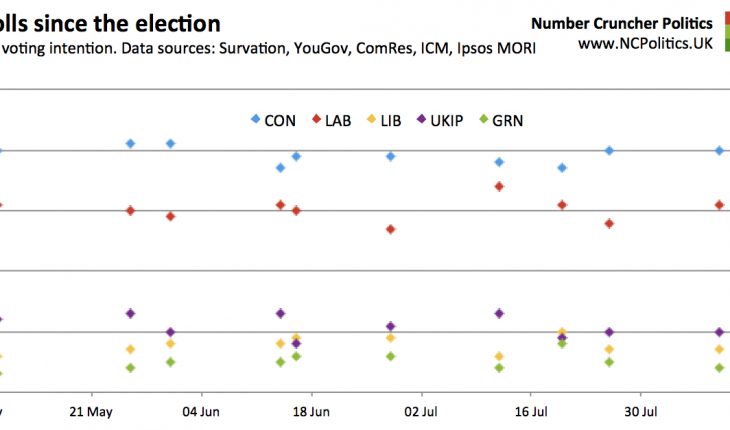Last week we got three voting intention polls, the most in any week since the election. However most of the debate at the weekend centred around the Labour leadership, as Survation and ComRes published seemingly contradictory findings regarding public perceptions of Jeremy Corbyn. Survation's quantitative video poll for the TSSA suggested that the Islington North MP came across best, while ComRes’s poll for the Independent on Sunday and Sunday Mirror suggested that he would be worst for Labour’s chances. Earlier in the week, Opinium had published a poll showing him right in the middle – in a narrowly-held second place. So who is right?
Well, I’m not sure there is a right answer, because the polls are measuring different things and in different ways. ComRes asked people to predict how Labour would fare, based on pre-existing knowledge. This “cold” approach is the conventional method, however relatively few “normal” people (those not interested in politics) will have much information about the candidates – and many won’t have heard of some of them. ComRes found 15% hadn’t heard of Jeremy Corbyn, rising to 24% for Liz Kendall. These are likely to be underestimates, because we know that some people tend to opine on things they don’t know about – for example, many voters give an opinion on fictitious candidates or legislation when asked.
Survation’s more novel approach involved presenting video clips of each candidate to the panel. This deals with the fact that voters often react to their “feel” about a candidate, how they present themselves, whether or not they seem prime ministerial, and so on. The problem with this method is that it may be sensitive to the particular clips chosen, and may prompt people to react to the clip, rather than also taking account of other information that may be important to them. This could happen subconciously, or indeed they may feel they’re being asked to do this.
Opinium asked current and potential Labour voting members of their panel who they would vote for in the Labour leadership election. They found that Andy Burnham did best among most groups, except for Green considerers, who prefered Corbyn.
And so we have different answers from different approaches – the fact is that it is very difficult to measure how people would vote in a hypothetical situation. Anthony Wells has written a detailed post on exactly this point. His view is that a Corbyn-led Labour party would struggle to win a general election, a view that I share given the likely reaction of the median voter in Nuneaton or Bedford or Keighley to his policy positions. However Corbyn’s supporters (correctly) retort that it would be extremely difficult for Labour to win the next election anyway, regardless of their choice of leader – for an overall majority, Labour would require a 1997-type swing, an extraordinary shift in opinion even under ideal conditions.
And these are far-from ideal conditions. Aside from the widely-discussed ideological divisions, the Labour party is faced electoral battles on multiple fronts, while nationally it is slipping back in terms of support rather than gaining. In 1992, Labour had taken the lead in some polls by now (there are technical caveats to this but the broader point stands). Looking at the 12 polls since the election, 6 (including 3 of the last 4) have had the Conservatives on 40% or higher and a different 6 have had Labour on 30% or lower, including 27% from the June ComRes survey, which was the worst poll for Labour while in opposition since September 1983.

The best news for Labour right now is that the Conservatives have their own battle over Europe to come – Europe having been a sore issue for the Tories 25 years. Party strife seems to be correlated to party performance, so it may matter whether David Cameron is seen to be doing well enough (and opinions will differ on what constitutes “enough”) versus the new Labour leader.
On the latest voting intention numbers, ICM’s monthly phone poll for the Guardian showed 9-point Tory lead, about two points of which can be attributed to ICM’s methodology changes. Based on their recontact work since the election, which suggested a slightly larger shy Tory factor than their adjustment had been picking up, they have increased the size and scope of the adjustment. Previously, 50% of those that didn’t know or wouldn’t say who they had voted for in the prior election, with total refusers (those who refused to say how they’d voted previously) removed altogether. Now, 75% of previous Labour and Conservative voters are reallocated (50% for other parties) along with an similar proportion of total refusers, except that the Conservative share of this group is increased by 5 points and Labour decreased by the same amount.
ICM/Guardian: CON 40 (+2) LAB 31 (-3) LIB 7 (+1) UKIP 10 (-3) GRN 4 (=) SNP 5 (+1) Note: New methodology
— NumbrCrunchrPolitics (@NCPoliticsUK) August 11, 2015
Survation, who haven’t made any methodological changes (but now weight to 2015 rather than 2010) found a 5-point Tory lead:
Survation/TSSA: CON 38 (-2) LAB 33 (+2) LIB 6 (=) UKIP 15 (+3) GRN 3 (=) SNP 5 (=) 12th-13th N=1,007 http://t.co/flQR8Z616L #newsnight
— NumbrCrunchrPolitics (@NCPoliticsUK) August 14, 2015
ComRes published their first online poll of this parliament. This isn’t directly comparable to their phone polls for the Mail, but it shows very similar results – an 11 point Conservative lead compared to 12 points in the last three polls.
ComRes/Indy (changes vs election): CON 40 (+2) LAB 29 (-2) LIB 8 (=) UKIP 13 (=) GRN 4 (=) 12th-13th N=2,035 http://t.co/BmDJAHqitV–-poll/
— NumbrCrunchrPolitics (@NCPoliticsUK) August 15, 2015
The main reason for ComRes showing much larger Tory leads at the moment is that its methodological changes have been more extensive – in particular Andy White’s new turnout model, which tends to increase the Conservative lead by about 4 points.



